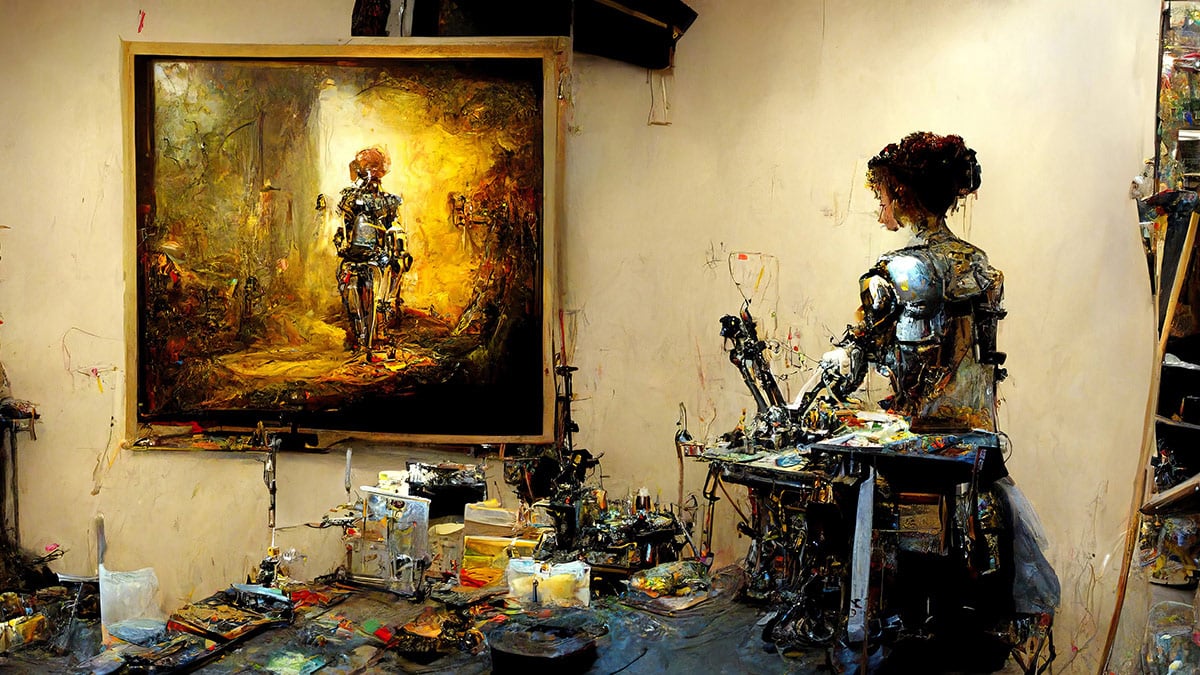6 Best AI Art Generators You Should Use (2022)
An explosion of quality tools from multiple sources, built on different AI models, is making AI art accessible to anyone with an internet connection. We wrote about making art with Dall·E earlier this year, but it seems like every month new technological breakthroughs are announced and new web tools become available for users to play with.
In this article, we will test six of the best AI image generators available in 2022. From the more popular art generators like DALL·E to lesser-known ones like Dream by WOMBO, the options are plenty. The image generators are not equal, but each has its own unique tools and features that you can play around with to show off your creativity.
AI generated images
AI art is artwork (visual, audio, or otherwise) generated by a machine learning process—that is, a machine has learned some information and now uses that information to generate a new image or modify an existing image. Humans may have collected the data and written the instructions for the machine to use, but the process of creation is left to the machine.
Most commercial and freely available AI image generators today take text as an input in the form of a prompt and generate pictures that match your prompt. The algorithms can be asked to create images in a range of styles, from oil paintings to CGI renders and even photographs, and the generated images may be strange, beautiful, or both!
AI art generator
1) NightCafe Creator
NightCafe Creator is an AI art generator with multiple methods of AI art generation. Using neural style transfer you can turn photos into masterpieces, and using text-to-image AI, you can create artworks from nothing but text prompts. It provides a range of styles and style masks so you can create artwork without watermarks in any way that appeals to you. The NightCafe app is available as a web service, and the company offers an app for Android and iOS phones. The name, NightCafe, is a nod to the app creator’s favorite real life artist, Vincent Van Gogh, who painted The Night Cafe in 1888.
NightCafe is a paid service. Each image generation prompt costs half a credit, and each credit costs 5–20 cents depending on how many you buy. Users get five free credits every 24 hours, even those who haven’t registered, and registered users get bonus credits for completing tasks like inviting friends or sharing their best creations in a public gallery.
2) Dream by WOMBO
Wombo, a Canadian firm that first gained notoriety for its AI-enabled lip syncing video app of the same name, has now released Dream by WOMBO. The Dream algorithm applies the CLIP-guided method, which is an open-source neural network developed by OpenAI’s research team.
The simplicity of usage and speed of setup are Dream’s major advantages. Even without creating an account, you can explore every function. It does not incorporate credit system limitations and instead lets you create unlimited paintings for free. While Dream does have a premium tier, starting at $4.99, you have more than enough art style variety to create free artwork from scratch. Simply enter the text prompt and choose an art style. You get literally dozens of different art styles to choose from, and if the premium tier is active, even more. Also, the iOS app can take an existing image and use it as a reference to the output image.
3) Midjourney
Midjourney is a small, self-funded research lab exploring and developing design, human infrastructure, and AI tools. The Midjourney Bot is a tool to generate AI images that operates on their official Discord server or on any other Discord server where the bot has been set up. Midjourney also offers a web app where users can find a gallery of their own work and other users’ creations. Midjourney is now in open beta, which means anyone can request to join.
The Midjourney bot uses machine learning to create pictures based on text. Your text prompt can be as fanciful as you want. You can include subjects, artistic styles, mood descriptors, and anything else. Currently, the bot seems better at creating artistic images than photographic ones.
The main downside to this AI image generator is that it can only be used with Discord, and you must sign up for a Discord account to access it. However, the details in the final output are so impressive that going through the sign-up process is worth it.
4) Dall·E 2
We covered Dall·E 2 earlier this year, and since then, this AI text-to-art generator has gone viral on the Internet. Made by the OpenAI research lab, it was initially closed off and available to select individuals with limited access. However, as time has passed and its model has improved, Dall·E 2 is now open to use for everyone, provided you sign up for an account. Dall·E 2 takes prompts and delivers life-like drawings. While it can take a while for images to be generated, its output is amazing. It can be used to generate images in a variety of scenarios, ranging from simple drawings to complex images.
Dall·E 2 gives you 50 credits that you can use to generate images. Each output equals one credit, and you can purchase more credits at a reasonable price
5) PhotoSonic
Photosonic is a web-based tool that lets you create realistic or artistic images from any text description, using a state-of-the-art text-to-image AI model that is based on latent diffusion, a process that gradually transforms a random noise image into a coherent image that matches the input prompt. You can control the quality, diversity, and style of the generated images by adjusting the description and rerunning the model.
The model can create images of landscapes, animals, objects, characters, scenes, or anything else a person could imagine, and it can customize images with various attributes and details. It can also enhance or modify existing images by adding text annotations or filters. One of its great features is its ability to convert an image into a painting.
Photosonic is still a work in progress, and both the model and user interface are constantly being improved to provide a better user experience. To use the tool, you have to sign up, and a free plan is available so that users can try the tool before subscribing to a paid plan.
6) Stable Diffusion
Stable Diffusion is an open-source AI art generator that was released in late 2022 by Stability AI. Thanks to its open-source model, anyone with a PC and a respectable GPU can create any visual reality they can envision; however, the license does forbid certain dangerous use scenarios in its terms of service. With a descriptive prompt, Stable Diffusion can mimic almost any visual style.
Stable Diffusion requires a 6.9 GB of VRAM on your GPU. With this processing power, it generates images at 512x512 pixels in a matter of seconds. For those without the required hardware, the company offers an online platform called DreamStudio where users can access the model using hardware provided by Stability AI. A public demonstration space is also available that allows anyone to instantly generate text-to-AI images without signing up.
Check out some of the amazing images that have been created by Stable Diffusion without preprocessing or postprocessing on their blog.
Although the image generator models mentioned here have already accomplished astonishing results, considering the growth in the technology this year alone, I expect further innovation to continue apace in the months and years to come. Try out the models for yourself to learn how AI sees the world.
*The opinions reflected in this article are the sole opinions of the author and do not reflect any official positions or claims by Acer Inc.
About Ashley Buckwell: Ashley is a technology writer who is interested in computers and software development. He is also a fintech researcher and is fascinated with emerging trends in DeFi, blockchain, and bitcoin. He has been writing, editing, and creating content for the ESL industry in Asia for eight years, with a special focus on interactive, digital learning.
Ashley is a technology writer who is interested in computers and software development. He is also a fintech researcher and is fascinated with emerging trends in DeFi, blockchain, and bitcoin. He has been writing, editing, and creating content for the ESL industry in Asia for eight years, with a special focus on interactive, digital learning.














